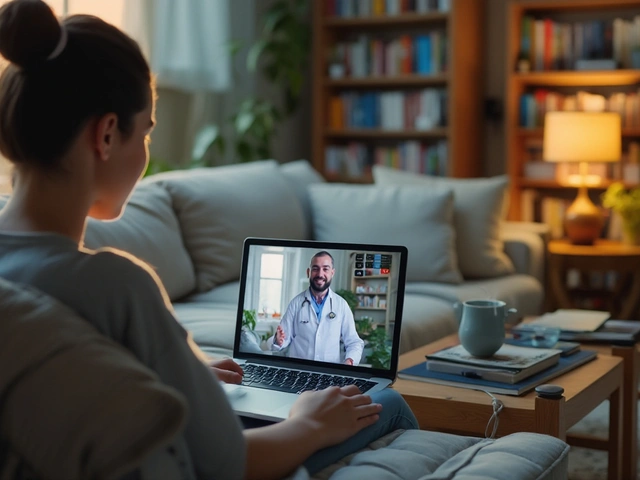Side Effect Impact Calculator
Your daily symptom reports help doctors adjust your treatment before serious issues develop. This calculator shows how your feedback could influence your care.
Every time you fill out a survey about how you’re feeling after taking a new medication, you’re not just answering questions-you’re helping save lives. Patient-Reported Outcomes (PROs) are your direct, unfiltered reports about symptoms, side effects, and daily functioning. No doctor translates them. No nurse filters them. They’re yours, exactly as you feel them. And now, they’re becoming a core part of how drugs are monitored for safety around the world.
Why Your Voice Matters More Than You Think
Clinicians track things like blood pressure, liver enzymes, and hospital visits. But what about the fatigue that makes you skip breakfast? The brain fog that makes you forget your child’s school play? The tingling in your toes that doesn’t show up on a scan? These are the things only you can report-and they’re often the earliest warning signs of a drug’s hidden risks. A 2019 FDA study found patients reported 30-40% more adverse events than doctors did. For fatigue? Patients reported it 4.2 times more often. For nerve pain? 3.8 times. For memory problems? Over five times more. These aren’t small differences. They’re life-changing symptoms that, if missed, could lead to unnecessary hospitalizations or even fatal complications. That’s why regulatory agencies like the FDA and EMA now require PRO data for many new drug approvals. In cancer treatments alone, over 89% of late-stage clinical trials now collect PROs. Why? Because when patients say, “I can’t walk to the bathroom without resting,” that’s not just a complaint-it’s a safety signal. And it’s one that can change a drug’s dosing, labeling, or even whether it reaches the market.How PROs Are Collected (And Why It’s Not Just Paper Anymore)
Gone are the days of handing out clipboards at clinic visits. Today, most PROs are collected electronically-through smartphone apps, secure web portals, or even automated phone calls. This shift has boosted response rates from 65% to over 85%. Why? Because it’s easier. You get a reminder on your phone. You answer while sitting on the couch. You don’t have to wait for your next appointment. These tools use validated questionnaires called PROMs-Patient-Reported Outcome Measures. These aren’t random surveys. They’re scientifically tested tools. For example, the PRO-CTCAE includes 78 specific symptoms rated by frequency and severity. PROMIS measures physical function with just 10-20 questions, but they’ve been tested on tens of thousands of people to make sure they’re accurate. Developing one of these tools takes 18-24 months and costs up to $750,000. That’s because every word matters. If a question says “How often do you feel tired?” instead of “How often do you feel exhausted?”-it changes how people respond. The FDA’s 2022 guidance for cancer drugs now requires three core PRO domains: symptomatic side effects, physical function, and disease-related symptoms. That means if you’re on a new chemotherapy, you’ll likely be asked about nausea, pain, ability to walk, and energy levels-using the same tools every time. This standardization lets regulators compare drugs fairly. It also means your feedback can be used to improve not just your treatment, but the next patient’s too.What Happens When You Report a Side Effect?
You might think, “Does anyone even look at this?” The answer is yes-and they’re looking harder than ever. When you report fatigue through a PRO app during a clinical trial, that data goes into a central system monitored by safety teams. If 15 people in a trial of 200 report severe fatigue within the first two weeks, that’s a red flag. It might mean the dose is too high. Or the drug interacts badly with something common, like a blood pressure med. That signal can trigger a safety review-weeks before a doctor notices a pattern in clinic notes. The PROSPER Consortium, formed in 2012, proved that PROs detect safety issues faster. While traditional reports took an average of 42 days to flag a problem, PRO reports caught them in 14 days. That’s a 67% faster response. In rare diseases or for elderly patients with multiple conditions, that speed can be the difference between a manageable side effect and a life-threatening one. And it’s not just trials. Once a drug is on the market, companies and regulators still use PRO data to monitor long-term safety. The FDA’s 2023 initiative to collect real-world patient reports through digital platforms means your feedback after leaving the trial can still shape drug warnings, patient guides, and even recalls.
The Downsides-and How to Avoid Them
PROs aren’t perfect. Some patients report feeling overwhelmed. One Reddit user said they had to fill out three different surveys three times a week. That’s not patient engagement-that’s a second job. A 2022 survey of 1,247 patients found 68% felt their feedback never led to any change in their care. That’s a trust issue. If you report pain and nothing happens, you stop reporting. That’s why the best programs give feedback. A simple message like, “Thanks for letting us know about your nausea. Your input helped us adjust your dose,” makes people feel heard. Another problem? Recall bias. If you’re asked to remember how you felt last Tuesday, you might forget. Studies show accuracy drops by 25% for events recalled after seven days. That’s why daily check-ins matter. Apps that send reminders at the same time every day help. So do simple scales-like a 1-10 pain rating-instead of long paragraphs. And not everyone has a smartphone. Older adults, low-income patients, and those in rural areas may struggle with digital tools. That’s why some trials still offer phone-based PROs or paper forms. Equity matters. A system that only works for tech-savvy people leaves others behind-and their safety risks unreported.What You Can Do Right Now
If you’re taking a new medication-whether it’s part of a trial or prescribed by your doctor-here’s what you can do:- Answer honestly. Don’t downplay symptoms because you don’t want to “bother” anyone. Fatigue, anxiety, sleep problems-they all count.
- Report consistently. Even if you feel fine, answer the survey. Missing data creates blind spots.
- Ask for feedback. “Can you tell me how my reports are being used?” If they can’t answer, that’s a red flag.
- Speak up about barriers. If the app crashes, the questions are confusing, or you can’t access it-tell the research team. They need to know.

What’s Next for Patient-Reported Outcomes?
The future is already here. Companies like Roche are using AI to scan patient forums and social media for unstructured reports like “I can’t think straight after taking this pill.” Their algorithms now catch adverse events with 82% accuracy. Pfizer is linking PROs to wearables-tracking how often you scratch your skin if you have eczema, and matching it to your self-reported itch. Novartis is using blockchain to keep your data private while still sharing it with regulators. By 2026, the EMA plans to require PRO data for nearly all new drug approvals. The FDA is moving the same way. This isn’t a trend. It’s the new standard. And it’s all because patients said: “We need to be part of this.”What exactly is a Patient-Reported Outcome (PRO)?
A Patient-Reported Outcome (PRO) is a direct report from a patient about their health, symptoms, or how a treatment affects their daily life-without any interpretation by doctors or researchers. For example, saying “I felt too tired to get out of bed three days this week” is a PRO. It’s not a lab result or a doctor’s note. It’s your experience, exactly as you live it.
Are PROs really used by drug regulators?
Yes. The U.S. Food and Drug Administration (FDA) and the European Medicines Agency (EMA) now require PRO data for many new drug approvals, especially in cancer, rare diseases, and mental health. The FDA’s 2022 guidance for cancer trials mandates specific PRO tools like PRO-CTCAE and PROMIS. Without this data, a drug may not get approved.
Can reporting side effects actually change my treatment?
Absolutely. One breast cancer patient reported severe fatigue through a PRO app, and her oncologist lowered her dose before she ended up in the ER. That’s not rare. PRO data helps doctors adjust doses, delay treatments, or switch medications to keep you safer. Your reports can directly change your care plan.
Why do I have to fill out so many surveys?
It’s not about busywork-it’s about accuracy. Side effects change over time. A symptom that appears after two weeks might be missed if you only report once a month. Daily or weekly check-ins catch patterns early. But if it feels overwhelming, tell the team. Many trials now use automated reminders and simplified tools to reduce burden.
What if I don’t have a smartphone or internet access?
You still have a voice. Many clinical trials offer phone-based PRO systems or paper questionnaires. If you’re being asked to use an app you can’t access, speak up. Regulatory agencies require that trials provide accessible options. Your safety shouldn’t depend on your tech skills.
Is my PRO data private?
Yes. PRO data is protected under the same privacy rules as your medical records. Companies use encrypted apps, secure servers, and anonymized data for research. Some, like Novartis, now use blockchain to ensure your data is only shared with permission. You have the right to know how your information is stored and used.





Comments (15)